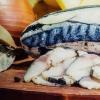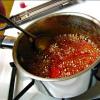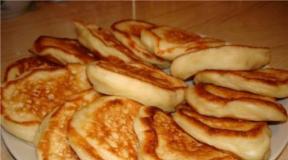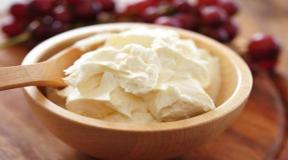Pun cheese. Camembert cheese product information and recipes
Camembert is probably the most popular French cheese in the world. Its history is so successful that it has been exported to many countries of the world in huge quantities for centuries, from Brazil to Japan. Here, in the post-Soviet space, it is not very popular. I myself met him not so long ago, so I decided to write this post in order to promote it to the masses.

This cheese belongs to soft cheeses with white noble mold, but inside it is soft and creamy. And a real Camembert is produced in the village of Camembert in Normandy and only there !!! It is also called "cow paradise", as there cows graze in the shade of apple trees and feed on selected wheat.

Camembert is usually done between September and May. The milk is delivered unpasteurized in 27 l tubs with lids. The best cheese is made from two servings - half of the curd is placed in the molds in the evening and the rest the next morning. For 4.5 liters of milk at a temperature of 27 ° C add 0.5 ml of rennet. Coagulation occurs after 2 hours and the milk should be stirred periodically, preventing the cream from settling. The curd is poured into metal molds mounted on straw mats on an inclined drying board. The cheese is left overnight, by morning it shrinks to about 2/3 of its original size. In the morning, the whole process is repeated, but before the new clot spills, the surface of the old clot in the molds is carefully disturbed. One day after adding the second curd, the cheese should be firm enough to turn over. This operation requires great skill.
When the clot lags behind the side walls of the mold, it is salted. The cheese is then placed on the shelves and flipped twice a day. When the development of a good white mold is clearly visible, the cheese is transferred to a drying room where the temperature and humidity can be adjusted. The optimum temperature is 13 ° C and the air is only slightly humid. The cheese now becomes viscous and is considered ripe. The product is transported in light wooden boxes or packed in straw, six cheeses at a time.

Separately, I would like to dwell on its usefulness. At the beginning of the 20th century, a doctor in the town of Vimoutier began to use Norman cheese to treat his critically ill patients. And not surprisingly, it contains vitamins of group B, A, D, E, K, sodium, potassium, calcium, phosphorus and other trace elements. It is recommended for arthrosis, arthritis, prevents the appearance of caries.
And the rich saturation with amino acids turns it into a panacea for AIDS and tuberculosis patients.
So, with what and how is it eaten? First of all, raw in the form of slicing with grapes or such canapes with berries and a glass of wine.

Camembert is also wonderful baked. It can be added to gratins, baked potatoes, pizza, pasta.

It can be cut into pieces, breaded in breadcrumbs and deep-fried (dipped in deep fat for literally 30 seconds).

You can also bake it in the oven by cutting off or cutting the top mold lid, sprinkling with lemon zest, garlic, rosemary, thyme, nuts or honey (8-10 minutes at 180 degrees).

Or bake in dough (puff or cheese), served with berry sauce.

Please yourself with Camembert !!!
Camembert is a soft and fatty French cheese covered with a velvety white mold crust. Outwardly, Camembert can be easily confused with brie cheese, but its fat content is much higher, which makes it seem more tender and creamy. The main feature of Camembert is the ease of melting - after a few minutes at room temperature, its middle softens and begins to flow. Reflections on the Camembert melting in the sun prompted Salvador Dali to the idea of "flowing hours". Camembert is mentioned by Emile Zola, Marcel Proust, Michel Legrand, Boris Vian and many other writers. Want to know more about this unusual cheese that can influence art? Culinary Eden will tell you how Camembert was invented, how it is prepared and what you can cook with it.

History of Camembert cheese
It is believed that Camembert cheese was first made in 1791 by a Normandy peasant, Marie Areles. During the French Revolution, she hid a monk from the province of Brie from persecution, and in gratitude for her salvation, he taught her how to cook cheese according to the secret recipe of her homeland - soft, creamy, covered with a dense mold crust. Since the "terroir" is very important for cheese - the climate, the composition of the soil and the varieties of grasses that cows eat, a Norman peasant woman living far from the central region of France has got a new type of cheese: not the ancient Brie cheese, but its younger brother, which is still had no name of its own and was simply called Norman cheese. For almost a century, Marie's descendants have been producing cheese according to this recipe, improving it and adapting it to local conditions.
In 1863, this cheese was introduced to Napoleon III as a product of the Norman village of Camembert. The emperor loved him very much and assigned the name of the place of origin to him. Thanks to Napoleon, the whole of Paris was carried away by cheese from Normandy, and the Arel family's cheese dairy had to urgently expand production. The cheeses were sent to Paris by train, which by that time connected the capital and the province.
 For a long time, Camembert cheese could only be tasted in France, since long-term transportation of such a delicate product was impossible. Thanks to the railway to Paris, he reached in 6 hours wrapped in straw, and this was the limit of his capabilities. It wasn't until 1890 that the engineer Riedel developed wooden boxes in which Camembert could be transported over long distances. Cheese immediately conquered America, and wooden boxes are still used to transport the real French Camembert.
For a long time, Camembert cheese could only be tasted in France, since long-term transportation of such a delicate product was impossible. Thanks to the railway to Paris, he reached in 6 hours wrapped in straw, and this was the limit of his capabilities. It wasn't until 1890 that the engineer Riedel developed wooden boxes in which Camembert could be transported over long distances. Cheese immediately conquered America, and wooden boxes are still used to transport the real French Camembert.
Interestingly, originally Camembert cheese had any kind of crust, but not white. Usually, a blue-gray mold with brown spots formed on it. Only at the beginning of the 20th century, this process was taken under control, and cheese makers began to use a special type of specially bred mold - Penicillium camemberti - which gives a beautiful snow-white crust. At the same time, at the beginning of the 20th century, doctors noticed that thanks to these fungi, Norman cheese can be successfully used to treat gastrointestinal diseases. However, it wasn't until the 1970s that the white crust became the official standard for Camembert.
 During World War I, camembert cheese circles in tin boxes were included in the ration of French soldiers. So he received popular love and became widely known throughout the world. In the 20th century, local varieties of soft cheese with mold, prepared according to the Camembert recipe, appeared in many countries. Although they have different names, their appearance and taste are very close to the classic Norman camumber.
During World War I, camembert cheese circles in tin boxes were included in the ration of French soldiers. So he received popular love and became widely known throughout the world. In the 20th century, local varieties of soft cheese with mold, prepared according to the Camembert recipe, appeared in many countries. Although they have different names, their appearance and taste are very close to the classic Norman camumber.
In 1928, a monument to Marie Arel was erected in the village of Camembert, without whom there would not have been its own famous cheese. In 1983, Camembert of Normandy received the AOC (Authenticity of Origin) certificate, which guarantees that the product is produced in a specific area in accordance with traditional technology.

Making Camembert cheese
Previously, Camembert was made from unpasteurized cow's milk, and Camembert from Normandy is still made according to the old recipe. In other regions, for safety reasons, pasteurized raw materials are used to make this cheese. One thing remains unchanged - milk should be whole, no powder or concentrates. It is slightly warmed up along with the mesophilic bacteria, rennet is added and left to curl. Already after an hour and a half, soft clots are carefully placed in cylindrical forms, trying not to violate their integrity. Every 6 hours, the molds are turned over so that the serum is glass from the surface, and the clots are combined into a homogeneous mass. A day later, a fairly hard cheese mass is formed in the molds. Each round of cheese is salted, sprinkled with a solution of Penicillium camemberti molds and left to ripen.
The cheese can be eaten after 12 days, but the rules prescribe that Camembert should be kept for at least 3 weeks. During this time, an edible moldy crust forms on the surface of the cheese, and inside it becomes soft and fluid. To obtain the highest quality Camembert, it is kept on the shelves for 35 days. The finished cheese is wrapped in paper and packed in wooden boxes. The standard size of a Camembert mug is about 10 cm in diameter and about 3 cm in height. The weight of such a mug is 350 g. In Russia, a real French Camembert is rare, but many stores have its worthy counterparts made in Germany. Delicious Camembert is also made in Italy, Switzerland, USA, Brazil and even in Japan.
 Camembert taste and aroma
Camembert taste and aroma
Now we are not able to appreciate the taste and aroma of the original Camembert of the 18th century, since both the raw materials and the technology of its production have changed a lot. However, a modern factory-made Camembert deserves no less attention. Compared to brie cheese, Camembert has a slightly spicier and richer flavor. Experts describe different types and varieties of Camembert in different ways: the taste can be with hints of milk, nuts, mushrooms, garlic, eggs, herbs and even fruits. The smell may be reminiscent of fresh cream, popcorn, mushrooms, or the gym, but never ammonia — it's a sign of overripe cheese.
 How to serve and eat Camembert
How to serve and eat Camembert
The consistency of camembert should be soft and fluid in the center and denser towards the edges. The moldy crust of Camembert should hold its shape well. To serve cheese like this, take it out of the refrigerator in advance and cut it into portions with a special cheese knife so that the pieces have time to melt slightly. You won't be able to cut a warm Camembert - its appetizing core will flow out at the slightest pressure.
Camembert, like brie, can be served on its own with nuts, herbs and sweet fruits, or it can be added to a cheese platter. In France, Camembert is eaten with a warm, crispy baguette. When baked, Camembert melts quickly and softens its taste; it is good to cook pies, pizza, hot sandwiches with it, or just bake it in a whole piece with herbs or fruits. The creamy spicy taste of Camembert is accentuated by young, low-tannin red wines, Calvados or cider.
Camembert's fat content is at least 45% fat in dry matter, so it is impossible to eat a lot of it. A small pack is enough for a cheese platter, salad or pie for 2 people.
 Camembert cheese recipes
Camembert cheese recipes
Fruit Salad with Camembert
Ingredients:
1 camembert circle
0.5 pineapple
1 kiwi,
1 orange,
1 pear
lettuce, corn, chicory.
For refueling:
olive oil,
lemon juice,
lemon zest
liquid honey.
Preparation:
Do not remove Camembert from the refrigerator until you need it, otherwise it will not be possible to cut it evenly. Rinse lettuce leaves, dry, tear with your hands and put on a plate. Place the diced fruit mixture on top. Remove the zest from the lemon on a fine grater, squeeze the juice, mix them with olive oil and honey. Cut the camembert into thin slices, place on top of the fruit and pour the dressing over the salad just before serving.
 Pie with camembert, tomatoes and olives
Pie with camembert, tomatoes and olives
Ingredients:
1 sheet of puff pastry (or 1 pizza base)
125 g camembert
10-12 pcs. cherry tomatoes,
1 glass of olives
2 cloves of garlic
3-4 sprigs of basil,
3-4 tablespoons olive oil.
Preparation:
Preheat oven to 200 ° C. Half a glass of pitted olives, garlic, 2 sprigs of basil and 2 tbsp. Using a blender, turn the olive oil into a smooth puree. Grease the surface of the dough with this sauce, leaving small sides. Top with the tomato halves, cut up, the remaining olives and camembert slices, and pour over with oil. Bake for 20-25 minutes on the top rack of the oven. Garnish with fresh basil leaves.
Camembert baked with aromatic herbs
Ingredients:
1 clove of garlic
3-4 sprigs of fresh thyme and rosemary,
1 tsp olive oil,
black pepper to taste.

Preparation:
Preheat oven to 180 ° C. Cut the top crust off the cheese and place it in the oiled ramekin or in the wooden box it was sold in. Use a knife to make several punctures in the cheese and insert small pieces of garlic into them. Disassemble the thyme and rosemary into small twigs and pierce the cheese with them. Season the cheese, drizzle with butter and bake for about 20 minutes, until golden brown. Eat warm.
Camembert in apple dough
Ingredients for 4 servings:
1 circle of camembert - 125 or 250 g,
2 sheets of puff yeast-free dough,
1-2 apples,
1 raw yolk
Preparation:
Preheat oven to 180 ° C. Cut 4 circles out of the dough. Cut the cheese into 8 slices, peel the apples and seeds and cut into thin slices. Place 2 cheese wedges and a few apple wedges on half of each circle. Brush the edges of the dough with yolk, carefully glue the edges to make semicircular patties. Bake on a paper-covered baking sheet for about 20 minutes.
Camembert cheese entered the dairy market of the countries of the former USSR after the end of the existence of a huge country. Therefore, few of the citizens living in the states created on the basis of the former Soviet republics have any information about this type of cheese. But "Camembert" has a history of creation, positive properties, peculiarities of preparation and use. It is also used as a constituent element of many dishes.
What is Camembert
Outwardly, "Camembert" bears great resemblance to cheese "Brie" (both of them are covered with snow-white mold). However, unlike Brie, which is made in the form of a triangular piece, Camembert is produced in the form of a circle.
Cheese has a lot of characteristics:
- high fat content and a more pronounced, rich creamy taste (in comparison with "Bari"), which tastes like eggs and mushrooms;
- the presence of a soft center and a dense mold crust;
- the property, under the influence of high temperatures, to take the form of a melted "ice cream" - this characteristic of cheese once helped Salvador Dali create his famous masterpiece "Flowing Clock";
- pleasant, fragrant smell.
History of creation
The creator of "Camembert" is considered to be a Norman peasant woman, Marie Arel (who lived in the village of Camembert) and a priest who was born in the province of Bree. In 1791 (during the French Revolution), Marie hid a priest in her house from persecution. At this time, a man taught a woman how to make cheese according to the recipes of the province of Bree. However, under the influence of the Norman climate and the use of local herbs (used in the production of "Camembert"), the produced cheese acquired a special taste.
Later, in 1863, this type of cheese was supplied to the table of the French emperor Napoleon Bonaparte. And the modern name of the cheese was given by the master of ceremonies of the emperor. Introducing the delicacy to Napoleon, he named it "Camembert" (after the village where it was created).
Positive and negative properties
Cheese contains a lot of choline, sodium, potassium. All of these minerals:
- help to strengthen the membranes of human cells and his cardiovascular system;
- have a beneficial effect on the growth and strength of teeth, nails, hair, bones;
- normalize cholesterol levels and prevent dehydration.
"Camembert" has a high calorie content (300 Kcal per hundred grams of product). Therefore, it is not recommended for use by persons on a diet.
Manufacturing technology
Cow's milk is used for the production of cheese. It is heated together with special bacteria. The rennet is added to the heated milk. After which it is fermented for an hour and a half until the formation of thickened curd.
The curd is placed in a cylindrical vessel, where it is kept for several days, until it turns into a homogeneous mass. The homogeneous mass is removed from the vessel and cut into pieces. Each piece is salted and sprinkled with Penicillium camemberti, after which it ripens for 30 days, until it is fully ready for use.
Rules for the use and serving of cheese
Camembert can be used as a stand-alone product or as a constituent element in other dishes. For example, in medieval Normandy, locals added this cheese to pastries and made a special fondue from it. Later, Camembert was used to make sandwiches.
There is a special technology for serving this dairy product. It can be:
- cut into pieces, lay on a saucer, garnish with nuts and fruits;
- cut into pieces, place inside a vase and garnish with raspberry, currant, strawberry or cranberry jam.
Camembert. This is one of those cheeses that can be considered truly popular in France. Moreover, the specific rich scent of Camembert inspired French writers and artists, leaving a noticeable mark on French literature and art.
He is mentioned in the works of such classics as Emile Zola, Marcel Proust. And the great Dali created on his canvas the famous image of "flowing hours" under the impression of Camembert cheese melting in the sun.
The surface of the creamy, fatty cheese is hard: it is covered with a hard mildew crust.
Camembert. History of Tender Cheese
The history of camembert cheese is associated with the name of the Norman peasant woman Marie Arel.
According to legend, in 1791 she helped a monk from Bree, who was threatened with a guillotine, to hide from persecutors, as well as many members of the clergy who opposed the revolutionary transformations that were taking place then in the country.
Having received a temporary shelter at the Marie Arel farm on the way to England, the monk, in gratitude, told the hardworking woman the secret of making a soft, tender cheese with a hard crust - Brie. According to sources, the monk's name was Charles Jean Bonvost.
It is no secret that one of the important "ingredients" of cheese is terroir - a complex of natural factors affecting the quality of the final product, including: the climatic features of the region, the quality of the soil, the vegetation that cows feed on. Neither the monk nor the peasant woman took this into account.
Since Normandy is located north of the Ile-de-France (it is to this region that the Brie region belongs), the natural and climatic features are different here. In general, Marie Arelle did not succeed in exactly copying the famous brie cheese, despite strict adherence to the recipe left by the monk.
But she invented a new type of cheese, which today is considered to be the younger brother of brie. At first it was called nothing less than Norman cheese. Over the centuries, the recipe for Camembert cheese (as it was later called) was perfected by the Areles family, more and more adapting to local realities, until it took pride of place in French. This is the answer to the question: what is the difference between Camembert and Brie?
In 1863, Emperor Napoleon III tasted cheese from the village of Camembert and was pleased with the product.
After this event, the fame of Norman cheese spread throughout France, which forced the Areles family to urgently increase production and raised the question of how to transport the product while preserving its valuable properties.
Initially, straw was used to transport the cheese. Scientific and technological progress also contributed: the intensive construction of railways between Paris and the regions, which began in the second half of the 19th century, significantly accelerated the process of delivering goods.
Only six hours on the way - and Camembert was delivered to Paris by rail, while retaining its freshness and aroma due to the fact that it was wrapped in straw.
At that time, this was the maximum possible time for transporting a delicate product; exporting it abroad was out of the question.
However, in 1890, the inventor Eugene Riedel developed special wooden boxes for these purposes, with the help of which long-term transportation of cheese became possible. This is how the taste of Camembert became known in the New World.
Moreover, this gave a large field for the development of the marketing component: bright branded stickers were placed on the cheese, by which the product was recognized all over the world.
Camembert today
Camembert cheese is soft, with a creamy taste, covered with a thin hard crust, and on top - a soft "carpet" of mold.
Initially, Camembert was covered with a gray-bluish mildew and literally strewn with brown spots.
But the development of microbiology made it possible to put cheese-making on a scientific track and thereby influence the aesthetic properties of the product. So, at the beginning of the 20th century, a variety of mold was bred - Penicillium camemberti - whose value for cheese making was that it gives the cheese a characteristic snow-white crust.

Scientists have found that these fungi help to cure a number of diseases of the digestive system.
A few more facts: during the First World War, Camembert cheese was included in the obligatory ration of the soldiers of the French army.
In the XX century, the recipe for making Camembert became known throughout the world. Local variations on the theme of delicate cream cheese appeared in America, Japan, Russia, etc. Moreover, not even a Frenchman can cook Camembert at home.
V In 1928, a monument to Marie Arelle was erected in her native village of Camembert, and in 1983 the legendary Norman cheese was awarded the AOC certificate (sign of controlled origin), confirming that the product was produced in the specified territory in compliance with the requirements of the traditional recipe.

Camembert goes well with fruit and wine. We invite you to be convinced of this by trying our branded.
We will tell you more about the recipe for Camembert cheese in our next post.
All about Camembert cheese. Energy value, vitamin and mineral composition. Why is this product useful and why should it be eaten in moderation? Gourmet recipes with Camembert. The history of cheese comes from France.
Camembert is a soft French cheese that belongs to the fatty varieties. From above it is covered with an elastic crust formed thanks to the microorganisms Geotrichum candidum and Penicillium camemberti. Inside is an ivory-colored liquid mass. Camembert has a very specific scent, which the French novelist called very aptly and poetically "the smell of the feet of God." The history of cheese dates back to 1791. There is a legend according to which a peasant woman named Marie Arelle saved a monk who was hiding from persecution, and he, as a token of gratitude, told her a secret culinary recipe for this amazing cheese. Camembert gained particular popularity during the reign of Napoleon III. However, today he has not lost fame, this French cheese is adored all over the world not only for its amazing taste, but also for its beneficial properties.
Features of making Camembert cheese

Cheese is made from cow's milk. The production process is very complicated and has a lot of subtleties and tricks, however, according to a simplified scheme, Camembert can be prepared at home on your own, and, according to amateur cheese-makers, the taste will turn out to be as perfect as that of a true cheese from France.
Camembert is a cheese with a short ripening period, which is definitely a plus for home cooking. After 5-6 weeks, you can already eat it.
However, of course, you cannot do without special equipment and components. To prepare Camembert, you will have to purchase additionally: a cheese mold, a thermometer for quick measurement of liquids, starter cultures, mold cultures Penicillium and Geotrichum Candidum, calcium chloride and an enzyme that curdles milk.
Let's take a look at how to make Camembert:
- Pour milk (3 liters) into a saucepan, salt to taste and heat to 32 degrees - control with a thermometer.
- When the milk is hot, pour in the mesophilic sourdough solution (75 ml), add both types of mold (on the tip of a knife) and mix gently.
- Pour in calcium chloride (10% solution, 10 ml), stir and wait 7-10 minutes.
- Add the milk curdling enzyme (0.1 g), previously diluted in warm water (50 ml), leave for half an hour.
- Cut the resulting curd mass into cubes of 1-2 centimeters and wait another 10 minutes.
- Heat the mass to 32 degrees, "cook" the cheese, according to Camembert's recipe, controlling the temperature (if it rises higher, turn off the heat), 15-20 minutes.
- Drain all the whey, and put the curd mass in a mold, trying to tamp the "grains". Leave it on for 2 hours.
- Turn the cheese over, then wait half an hour and turn over again. Repeat the procedure 7-8 more times.
Camembert is almost ready, it only has to mature. To do this, transfer the head to a plastic container, previously covered with napkins. Turn the head over and change the napkins every day. After 10-12 days, the Camembert at home will be evenly covered with mold, wrap it in foil and refrigerate for 4 weeks.
- Read also about
Composition and calorie content of Camembert cheese

Camembert has a standard calorie content for cheeses, but its composition is atypical, if most cheeses have almost the same protein and fat content, then there is a clear preponderance towards the latter.
The calorie content of Camembert cheese is 324 kcal per 100 grams, of which:
- Proteins - 15.3 g;
- Fat - 28.8 g;
- Carbohydrates - 0.1 g;
- Water - 52 g.
The product has a good vitamin and mineral composition.
Minerals per 100 g:
- Potassium - 75 mg;
- Calcium - 510 mg;
- Magnesium - 15 mg;
- Sodium - 800 mg;
- Phosphorus - 390 mg;
- Iron - 0.3 mg
Vitamins per 100 g:
- Vitamin A, RE - 303 mcg;
- Retinol - 0.27 mg;
- Beta carotene - 0.2 mg;
- Vitamin B1 - 0.05 mg;
- Vitamin B2 - 0.42 mg;
- Vitamin B5 - 1.1 mg;
- Vitamin B6 - 0.25 mg;
- Vitamin B9 - 62 mcg;
- Vitamin B12 - 1.3 mcg;
- Vitamin C - 0.4 mg;
- Vitamin D - 0.93 mcg;
- Vitamin E - 0.3 mg;
- Vitamin H - 5.6 mcg
- Vitamin PP, NE - 5.6 mg mg;
- Niacin - 0.4 mg
Also included in Camembert cheese:
- Mono- and disaccharides - 0.1 g;
- Cholesterol - 78 mg;
- Saturated Fatty Acids - 18.3 g
Useful properties of Camembert cheese

The benefits of Camembert cheese were actively discussed at the beginning of the 19th century, some doctors even used the product in medical practice and, importantly, received a positive result. As for modern research, they also testify in favor of Camembert - the product has an excellent amino acid composition and is a real storehouse of vitamins and minerals.
The benefits of Camembert cheese for the body are as follows:
- Complete protein source... The protein contained in the product has a good balance in the composition of amino acids, which makes it a particularly useful nutritional component for athletes and people of physical labor.
- Strengthening bones... Cheese is a well-known storehouse of calcium, while the product also contains auxiliary substances for its absorption - phosphorus and vitamin D. Thus, eating Camembert, you can be sure that the mineral is not only supplied to the body, but also well absorbed. This property is especially important for women during menopause, who are known to be at risk of developing osteoporosis.
- Normalization of the digestion process... In the preparation of Camembert cheese, special strains of mold are used that are beneficial for the human gastrointestinal tract. The microorganisms included in the product are friendly to the microflora contained in the intestines, therefore, its regular use improves digestion.
- Protects skin, teeth and gums... Turkish scientists have recently studied in detail the influence of molds on Camembert cheese on humans. As a result, additional effects were found out. Firstly, fungi tend to accumulate under the skin, stimulate the production of melanin and protect against sunburn. Molds are also effective in preventing and treating tooth decay.
- Energy metabolism support... Vitamins of group B are well represented in cheese, in combination, they have a positive effect on all metabolic processes in the body. In addition, the B vitamins have an important effect on the regulation of the nervous system.
- Protection of the cardiovascular system... Camembert is high in potassium, a macronutrient that plays an important role in the healthy functioning of the cardiovascular system. The mineral regulates rhythm and pressure.
- Read also about
Contraindications and harm of Camembert cheese

It is important to use Camembert in moderation, you should not exceed the rate of 50 grams. This recommendation should be adhered to by all people, even those who do not have health problems. The fact is that this product, although healthy, is high in calories and high in fat content. In addition, industrial cheese is salted for a long time in aqueous solutions, as a result of which there is much more salt in it than in homemade Camembert. The increased sodium content in the diet disrupts the harmony of the most important fluid and mineral metabolism in the body.
Even when consumed in moderation, Camembert cheese can be harmful when:
- Lactase deficiency... In cheese, milk sugar (lactose) is much less than in milk, however, in severe forms of the disease, even such a dose will not be able to be digested and provoke intestinal upset. In milder forms of insufficiency, you can eat a small piece of cheese.
- Obesity... A product of such fat content in obesity of any degree is unacceptable in the diet.
- Heart disease... In this case, the sodium-potassium balance is especially important, therefore, before using the product, it is imperative to consult a doctor.
Also, a consultation with a doctor is necessary if, for medical reasons, you are prescribed this or that therapeutic diet.
- see also
Camembert cheese recipes

The taste of Camembert is multifaceted, according to various versions of cheese connoisseurs, this delicacy has a pronounced milky taste with hints of mushrooms, eggs, nuts, herbs, fruits and garlic. However, if the taste is difficult to describe, then the specific moldy smell will allow you to recognize Camembert from thousands of other cheeses.
On a cheese platter, it is served with fruit, nuts and a fresh baguette - ideally still warm. Young wine - white or rosé - is considered a classic drink for it; cider and apple vodka (calvados) can also be used as an alcoholic accompaniment.
In France, an incredibly tasty and simple dish is often prepared from Camembert with mold - baked cheese. A generous amount of cheese is simply wrapped in puff pastry and sent to the oven. This pie is usually served with berry sauce.
However, you can use cheese in a quite classical way - use it in making pizza, hot sandwiches, casseroles, sauces, soups, etc.
Here are just a few interesting recipes with Camembert cheese:
- Trout baked with vegetables and cheese... Cut the zucchini (100 grams) into cubes, the cherry tomatoes (100 grams) into halves, chop the onion (20 grams) and garlic (1 clove). Prepare thyme leaves (2 grams). Trout (150 grams), rinse, peel, remove the skin and cut into large cubes. For capers (50 grams), cut off the stem, Camembert (50 grams) cut into random pieces. Shape the foil into a pot, lay out all the vegetables (except garlic) with the bottom layer, then trout, garlic, thyme, add salt and pepper to taste, spread Camembert and several slices of butter (30 grams) on top. Bake, without covering the foil, for 10-15 minutes at a temperature of 220 degrees. Serve directly in foil.
- Breakfast sandwich... Cut a small ciabatta lengthwise, fry each side in a pan on one side - where there is no crust. Mix honey (2 tablespoons) - if sugared, melt beforehand. Put on the prepared bread first the green salad leaves, then the Camembert plates, chopped figs (2 pieces) and a mixture of honey and nuts.
- Camembert and salmon pie... Mix flour (300 grams) with salt and butter (100 grams). Stir the dough by hand until smooth. Add water (7 tablespoons), stir and roll. Transfer the dough into a mold, shape the sides, bake for 10 minutes in an oven preheated to 180 degrees. In the meantime, prepare the filling. Fry the onion (100 grams) in butter, when it turns golden, add the cream (50 ml) and simmer until soft. Put the prepared onion on the dough, then put the salmon fillet cut into thin slices (200 grams). In a separate bowl, beat eggs (2 pieces) with cream (100 ml), season with salt and pepper, and pour the mixture over the pie. Spread thin Camembert plates (120 grams) on top. Bake in the oven at 180 degrees for half an hour.
- Millet porridge ala risotto... Cook millet (100 grams) separately in water until tender and season with butter to taste. Fry the porcini mushrooms (50 grams) in a skillet. In a small saucepan, heat the chicken stock (500 ml), add the cream (50 ml) and then the white wine (50 ml). Reduce heat and start gradually adding cheeses - Camembert (50 grams), Taleggio (50 grams), Parmesan (80 grams). The result should be a thick cream. Put the millet on a plate and serve with cheese cream and herbs to taste.
- Spinach salad with walnuts and Camembert... Spinach (1 handful), rinse and dry. Chop the cheese (30 grams) and crab sticks (3 pieces) finely. Boil an egg (1 piece) and cut it in half, also do with cherry (5 pieces). Chop walnuts (5 pieces). Combine all ingredients, season with olive oil, salt and pepper to taste.
As you can see, Camembert perfectly complements any dish: it will be appropriate in a fresh salad, and a hot pie, and in an original side dish, and in an exquisite sandwich.
- see also

There is a legend according to which the artist Salvador Dali depicted his most famous "flowing hours" under the influence of the taste and type of Camembert cheese.
Cheese gained particular popularity during the time of Napoleon III; it was adored by aristocrats and connoisseurs. It is noteworthy that in popularity it has significantly surpassed its "ancestor" - Brie cheese. Marie Harel, whose name is associated with the appearance of Camembert, in fact, should have been received by Bree.
The monk, whom Mari hid in her house, fled from the province of Bree, which was famous for making this cheese. But since the weather and feeding conditions in the Norman village of Marie were somewhat different, the cheese tasted differently. By the way, the village was called Camembert. So we got two similar cheeses - both in appearance, and taste, and even in the origin of the names, but they are still different.
You can distinguish between Brie and Camembert on sale today by their typical shapes: the first is sold in the form of a triangle, and the second is in the form of a circle.
Before serving, Camembert needs to be kept at room temperature for a while, so it will acquire a delicate soft texture.
Do not confuse the "noble" scent of mold with the pungent smell of ammonia, which means that the cheese was either improperly prepared or stored incorrectly, or the expiration date has already expired. Eating such a product is strictly prohibited.
True Camembert is prepared only in Normandy, and there are a lot of subtleties in the production. Due to certain temperature conditions, cheese is prepared only during the cold season - from September to May.
Watch the video about Camembert cheese:
Camembert is one of the most original cheeses in the world, hard on the outside and soft on the inside, with a multifaceted taste and specific aroma. It has many uses in cooking, but if you want to taste it, just serve it on a cheese plate with fruits, nuts and white wine. The product contains many vitamins and minerals, in moderate doses it is beneficial for health. You should not abuse Camembert, it is absolutely necessary to avoid it in the diet with lactase deficiency, overweight and diseases involving a strict diet.
- Article


















